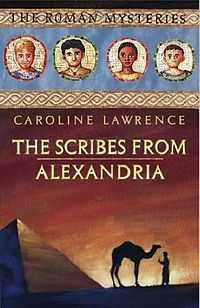The Scribes from Alexandria
|
First edition cover | |
| Author | Caroline Lawrence |
|---|---|
| Cover artist |
Peter Sutton, Fred van Deelen |
| Country | United Kingdom |
| Language | English |
| Series | The Roman Mysteries |
| Genre | Historical novel |
| Publisher | Orion Children's Books |
Publication date | 26 June 2008 |
| Media type | Print (Hardback & Paperback) |
| Pages | 260pp (first edition, hardback) |
| ISBN | 1-84255-190-6 |
| OCLC | 220001063 |
| Preceded by | The Beggar of Volubilis |
| Followed by | The Prophet from Ephesus |
The Scribes from Alexandria is a children's historical novel by Caroline Lawrence. The novel, the fifteenth in the Roman Mysteries series, was published in 2008. It is set during the reign of Titus, primarily in Roman Egypt.
Plot introduction
The novel is set in early summer AD 81. After a shipwreck, the children are separated. Flavia, Jonathan and Lupus go around Alexandria and up the Nile following a trail of clues laid by a mysterious eunuch to find Nubia, who believes they are all dead.
Plot summary
The story starts with Nubia struggling in the sea and Flavia waking up on a beach. On the way home to Ostia from Volubilis, they have suffered shipwreck. Flavia soon finds Lupus and Jonathan alive, but Nubia and Flavia's uncle Gaius are missing. Nubia has been seen in the company of one of the scribes from the Library, but the scribe, a eunuch called Chryses, cannot be found.
The Head Scholar assigns another young scribe, a devout Jew called Seth ben Aaron, to go with the children to find Chryses and Nubia. Starting in Chryses's sleeping quarters they find a trail of riddles and anagrams leading to different places in Alexandria, and then to the Great Pyramid. Their search is complicated by the fact that they are being pursued by Roman soldiers.
Seth's cousin Nathan, a smuggler, takes them up the Nile on his sailing boat, hoping to find treasure. They find more clues leading far up-river and realise that Nubia is returning to her native land. They follow, but wonder if Nubia will want to go back to Ostia with them.
Some of the chapters describe Nubia's journey with Chryses, by donkey-cart and camel, and her meeting with other members of the Leopard clan on Elephantine, an island in the Nile on the southern Egyptian border.
Allusions to actual history and geography
The first part of the book gives a glowing account of the beauties of ancient Alexandria, including the wide streets and the healthy atmosphere. The clue trail, which begins at the famous Library, leads to many of the notable places of the city, including the park dedicated to Pan, the temple of Serapis and the sarcophagus of Alexander the Great. The children also see the Lighthouse, one of the Wonders of the World.
In the second part, the journey up the Nile leads past the various towns and mud villages of ancient Egypt, which are strung out along the river. From the Nile Delta, they join the Nile proper at Heliopolis. They visit Crocodilopolis where they see the sacred crocodile, Apollonospolis where Lupus visits the great Temple of Horus, and Cynopolis where they all witness an attack by the Oxyrhynchites.
They also see the Pyramids, including another of the Wonders, the Pyramid of Khufu, the Valley of the Kings, the Colossi of Memnon, and the Nilometer on Elephantine.
Themes
Concealment is a theme which runs through the book. Disguise is common: Flavia encounters revellers from a costume party, Seth and Jonathan twice disguise themselves as Egyptian women, Flavia and Nubia spend most of the journey up the Nile dressed as boys, and Lupus exchanges clothes with a beggar boy. Flavia and Lupus hide from soldiers in the concealed hold on the smuggler's boat, and later in a secret passage in a temple. Placenames are concealed in riddles and anagrams. Apparent friends turn treacherous and rivalries are not what they seem.
The various religious practices in ancient Egypt are another theme. Many temples are visited, beginning with the Temple of Poseidon where the children give thanks after surviving the shipwreck. The creation of Serapis, a human-looking amalgam of Osiris and Apis designed to appeal to both Egyptians and Greeks, is explained. The animal-headed gods of Egypt, particularly Sobek and Anubis, and their associated sacred animals, are often referred to. Alexandria had a large Jewish population, and the religious tensions between the Jews and the Egyptians are expressed through Seth, who is very scornful of the pagan practices and superstitions, and is faithful in his own devotions, including keeping Sabbath. Jonathan joins him and Nathan in Jewish prayers, and does not mention being a Christian.
External links
| ||||||||||||||||||||||||||||||
